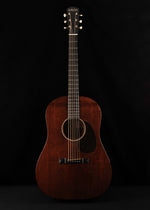
S/N #6013
During The Great Depression at the end of the 1920s, guitar manufacturers were struggling, though there were still a few sales bright spots, like the sales figures for the least expensive models. Gibson and C. F. Martin & Co. expanded their offerings at the bottom of their range, offering mostly smaller bodied guitars with Mahogany tops instead of pricier spruce.
The Santa Cruz 1929/D12 is sort of a “what if?” guitar: what if Martin offered an X-braced Mahogany top Dreadnought in the 1930s? The D12’s dimensions are taken from the earliest twelve fret Martins, first those made for Ditson & Co. and then those from the introductory year in the C. F. Martin catalog, 1934. The guitar top, back, sides and neck are made of “True Mahogany” according to the SCGC literature. The fingerboard, headplate and bridge are ebony.
The headstock, known as the Solid VJ, features a Santa Cruz Ivorioid Script inlay and it currently has Waverly open back tuners with aged Ivoroid buttons installed, though the original black button Santa Cruz tuners are included with the sale. The neck joins the body at the twelfth fret, the scale length is 25.375,” the nut width is 1 ¾” and the bridge spacing is 2-3/16.” There are no fret markers on the fingerboard, though there are side dot markers at the third, fifth, seventh, ninth, twelfth, fifteenth and seventeenth frets, with a total of nineteen frets. The neck is a “V” profile with a neck depth of 0.850” at the first fret and 0.940” at the eighth fret.
The body binding is also Mahogany for both the top and back and a single line of black purfling on the top, sides and back. The rosette is a single ring with three ply Ivoroid-Toroise-Ivoroid. It is mounted with a D12-1929 shape Tortoise pickguard. The bridge is delicately carved in the pyramid style popular at the end of the 1920’s. The soundhole is 4 ½” in diameter. The body length is 20-1/16,” the width at the lower bout is 15 ½,” the upper bout is 11 ⅛,” and the body depth is 4 ¼.”
Overall, this instrument shows only the slightest signs of wear or use. The tuners were swapped and the bridge saddle was aged at some point. Both of these can be corrected upon request. There are a few small scuffs, mostly on the back and the originally matte finish of the neck has been polished through years of careful play. The frets are lightly worn with some slight divoting up to the fifth fret. This can also be addressed upon request.
We asked Richard Hoover about this particular model. He stated that only a couple were ever made. There is a left-handed D12-1929 mentioned on the Acoustic Guitar Forum and a couple of sales records for a right-handed example. They might all be for this guitar, or there might be another right-handed model out there. Either way, this is a rare and unusual instrument with a fantastic voice. It has aged in well and each note rings with the clarity and focus generally reserved for mahogany topped pre-war Martins and wartime Gibsons.









